You might say Rhode Island’s growing conditions can be “challenging,” but that’s just a polite way of describing the salt spray, sandy soil, and unpredictable coastal weather that can make or break your garden. However, you’ll discover that certain native species actually prefer these tough conditions, thriving where other plants struggle. These resilient performers have evolved alongside Rhode Island’s unique climate for thousands of years, developing specific adaptations that make them surprisingly low-maintenance once established.
Contents
- 1 Coastal Climate and Soil Conditions
- 2 Wildflowers for Coastal Gardens
- 3 Heritage Trees for Rhode Island
- 4 Rhode Island’s Hardy Native Shrubs
- 5 Selecting the Right Native Plants for Your Garden
- 6 Frequently Asked Questions
- 6.1 How Do I Propagate Native Rhode Island Plants From Seeds?
- 6.2 What Native Plants Attract Butterflies and Hummingbirds in Rhode Island?
- 6.3 When Is the Best Time to Plant Native Species in Rhode Island?
- 6.4 How Do I Control Invasive Species That Compete With Native Plants?
- 6.5 What Native Plants Are Deer-Resistant in Rhode Island Gardens?
Coastal Climate and Soil Conditions
While Rhode Island’s compact size might fool you into thinking it has uniform growing conditions, the Ocean State’s coastal climate creates a complex patchwork of microclimates that directly impacts which native plants will thrive in your garden. Coastal areas average 51°F annually, while inland spots drop to 48°F. Your sandy, well-drained coastal soils contain little organic matter and face constant salt spray exposure.
These challenging conditions demand coastal adaptation strategies from your plants. Successful native species must handle soil salinity management naturally, tolerating nutrient-poor substrates while withstanding increasing storm intensity and projected sea level rises up to four feet by 2100. Native plants also help combat the 14% of impervious cover in the Narragansett Bay watershed by reducing nutrient run-off that contributes to harmful algal blooms in coastal waters.
Wildflowers for Coastal Gardens
Rhode Island’s coastal environments present unique challenges that native wildflowers have naturally adapted to overcome, offering beautiful, low-maintenance solutions for seaside gardens. These resilient plants are drought-tolerant once established, making them ideal for sandy coastal soils and salt spray conditions.
New England Aster
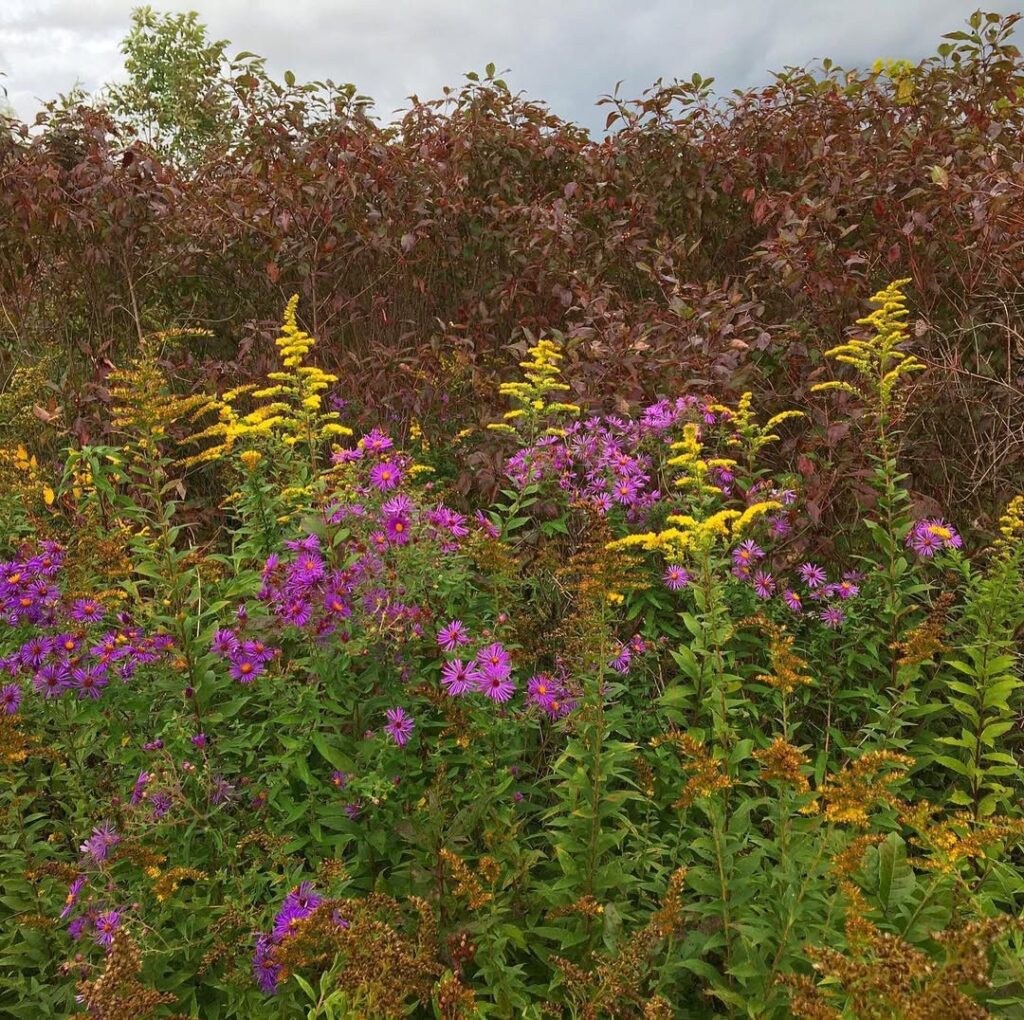
New England Aster is a stunning native perennial that brings vibrant late-season color to coastal Rhode Island gardens. This robust wildflower produces dense clusters of bright rose-purple flowers with orange-yellow centers from August through November, making it one of the most valuable nectar sources when other blooms have faded. Growing 1-6 feet tall with distinctive lance-shaped leaves that clasp hairy stems, this adaptable plant thrives in Rhode Island’s diverse coastal conditions while supporting essential pollinators like migrating monarchs and native bees. As the plant matures, it naturally loses lower leaves while directing energy toward spectacular blooms that create stunning displays in meadow gardens.
- Hardiness: Zones 4-8, well-suited to Rhode Island’s climate
- Light: Full sun to partial shade
- Water: Moderate to high; tolerates both wet and dry conditions
- Soil: Adaptable to various soil types including sandy, moist, and moderately dry soils
- Fertilizer: Low maintenance; no supplemental fertilizer needed
- Pest/Disease Resistance: Generally resistant with good tolerance to coastal conditions
- Growth Rate: Moderate to fast, spreads naturally in clumps
Seaside Goldenrod

Seaside Goldenrod is a resilient native perennial perfectly adapted to Rhode Island’s challenging coastal conditions. Growing 3-8 feet tall with dark green, waxy succulent leaves, this plant produces spectacular bright yellow blooms from late summer through fall when few other flowers are available. Its exceptional salt tolerance and drought resistance make it invaluable for coastal gardens, while its late-season nectar provides essential food for pollinators preparing for winter.
This clumping perennial develops dramatic arching stalks that create striking vertical interest in naturalized areas and coastal landscapes. The plant’s succulent, lance-shaped leaves help it withstand salt spray and harsh maritime conditions, while its evergreen basal foliage provides year-round structure. Seaside Goldenrod is excellent for creating dramatic drifts of late-season color and pairs beautifully with other native coastal species. The seeds feature distinctive white pappus hairs that aid in wind dispersal across coastal environments.
- Hardiness: USDA zones 4-9
- Light: Full sun to partial sun
- Water: Low to moderate; drought tolerant once established
- Soil: Sandy, well-draining soils; tolerates poor and alkaline conditions
- Fertilizer: None required; thrives in nutrient-poor soils
- Pest/Disease Resistance: Excellent; very few pest or disease issues
- Growth Rate: Moderate; forms expanding clumps over time
Wild Bergamot

Wild bergamot (Monarda fistulosa) is a native perennial wildflower that thrives in Rhode Island’s coastal environment. This aromatic member of the mint family produces clusters of pink to lavender flowers from summer through fall, making it an excellent choice for extended seasonal interest. Growing approximately 3 feet tall with lance-shaped, toothed leaves, wild bergamot spreads naturally through creeping rhizomes to form attractive clumps in the garden landscape.
An outstanding pollinator plant, wild bergamot attracts butterflies, bees, and hummingbirds with its abundant nectar-rich blooms. The aromatic foliage releases an oregano-like scent and can be used for making herbal tea. Its adaptability to various growing conditions and tolerance for coastal garden challenges makes it particularly valuable for Rhode Island gardeners seeking low-maintenance native plants. Wild bergamot is also valued as a flavoring agent in culinary applications beyond tea preparation.
- Hardiness: USDA zones 3-9
- Light: Full sun to partial shade
- Water: Medium moist to dry conditions, drought tolerant once established
- Soil: Wide range of well-drained soil types, prefers rich soils, tolerates limy conditions
- Fertilizer: Low maintenance, no special fertilizer requirements
- Pest/Disease Resistance: Generally resistant to most pests and diseases
- Growth Rate: Moderate, spreads gradually through rhizomes to form colonies
Beach Pea

Beach pea is a native perennial trailing vine that serves as an excellent wildflower choice for Rhode Island coastal gardens. This hardy plant features distinctive succulent bluish-grey leaves and produces beautiful pink to purplish-blue, pea-like flowers in clusters from May through August. Growing up to 2 feet in height, beach pea thrives in the challenging conditions of beaches, dunes, and salt marshes.
Beyond its ornamental value, beach pea provides significant ecological benefits through its deep root system that helps stabilize sand and prevent coastal erosion. The plant attracts native pollinators and serves as a food source for coastal wildlife. Its ability to tolerate high salt levels and calcium carbonate makes it ideal for shoreline restoration projects and natural coastal garden settings. The seeds float and remain viable for extended periods in sea water, contributing to the plant’s widespread distribution along coastlines.
- Hardiness: Zones 3-8
- Light: Full sun
- Water: Moist to wet conditions; drought tolerant once established
- Soil: Sandy, gravelly, well-draining; high salt and calcium carbonate tolerance
- Fertilizer: Low requirements; adapted to nutrient-poor coastal soils
- Pest/Disease Resistance: Excellent; rarely experiences significant issues
- Growth Rate: Moderate; spreads via trailing growth habit
Wild Lupine

Wild Lupine stands as one of Rhode Island’s most striking native wildflowers, producing dramatic spikes of vivid blue to purple pea-like blooms from April through July. This perennial herb reaches up to 2 feet tall with distinctive palmately compound leaves and serves as an essential host plant for the federally endangered Karner Blue Butterfly. Its deep taproot and nitrogen-fixing capabilities make it invaluable for coastal restoration projects and native garden designs throughout the region. The plant also provides important forage for wildlife, as deer browse the foliage while birds and small mammals consume the seeds.
- Hardiness: Zones 4-8, well-adapted to Rhode Island’s coastal climate
- Light: Full sun to partial shade, thrives in open woodland clearings
- Water: Low to moderate water needs once established, drought tolerant
- Soil: Well-drained sandy or gritty soils, pH 6.8-7.2, intolerant of heavy clay
- Fertilizer: None required due to nitrogen-fixing root nodules, avoid high-nitrogen fertilizers
- Pest/Disease Resistance: Generally resistant to pests and diseases when grown in appropriate conditions
- Growth Rate: Moderate establishment in first year, vigorous growth once root system develops
Heritage Trees for Rhode Island
Rhode Island’s heritage trees represent living monuments of native species like maples, oaks, and pines, recognized through decades of documentation for their historical significance, ecological value, and conservation importance. These magnificent specimens serve as crucial habitat for threatened and endangered species that depend on mature forest ecosystems for their survival.
Eastern Red Cedar

Eastern Red Cedar is an evergreen conifer native to eastern North America, including Rhode Island. This aromatic tree starts with a narrow, columnar shape when young but develops a broad, irregular crown with age. Typically reaching 30-40 feet tall, it can grow up to 90 feet in ideal conditions. The tree features scale-like foliage ranging from gray-green to blue-green, soft silvery bark, and pale blue berry-like cones on female trees.
Known for its exceptional adaptability, Eastern Red Cedar thrives in diverse habitats from woodland edges to abandoned fields. It serves as a valuable pioneer species, quickly establishing on disturbed lands, and provides important wildlife habitat. With lifespans exceeding 500 years, these heritage trees have significant historical and ecological value in Rhode Island’s landscape. The species has a remarkably wide distribution across 37 states in the USA.
- Hardiness: USDA zones 2-9, extremely tolerant of heat, cold, and drought
- Light: Full sun to partial shade
- Water: Drought tolerant once established, adaptable to wet or dry conditions
- Soil: Highly adaptable, pH 4.7-7.8, tolerates poor, rocky, acidic, alkaline, and swampy soils
- Fertilizer: Low to no fertilizer requirements, thrives in poor soils
- Pest/Disease Resistance: Generally resistant, but serves as alternate host for cedar-apple rust
- Growth Rate: Moderate, 1-2 feet per year when young, slower on adverse sites
American Chestnut

The American chestnut once dominated eastern US forests, including Rhode Island, covering approximately 200 million acres before being devastated by chestnut blight. This heritage tree was a cornerstone species in oak-chestnut forests, providing essential food resources for wildlife and contributing considerably to forest structure and biodiversity.
Today, American chestnuts survive primarily as rootstock sprouts that typically succumb to blight before reaching maturity. Despite this decline to 1-10% of original populations, the species retains substantial genetic diversity vital for restoration efforts. Conservation initiatives in Rhode Island focus on protecting existing trees and supporting breeding programs to develop blight-resistant varieties. The American Chestnut Foundation operates breeding orchards in South Kingstown, Westerly, Glocester, and Foster with 200-300 trees each as part of ongoing restoration efforts.
- Hardiness: USDA zones 4-8, well-adapted to Rhode Island’s climate
- Light: Full sun to partial shade, tolerates mixed forest conditions
- Water: Moderate water needs, suited to Rhode Island’s average precipitation
- Soil: Acidic, well-drained loam soils with pH below 6.8; intolerant of calcareous soils
- Fertilizer: Minimal requirements in native forest settings
- Pest/Disease Resistance: Highly susceptible to chestnut blight (Cryphonectria parasitica)
- Growth Rate: Fast-growing when healthy, but growth limited by blight susceptibility
White Oak
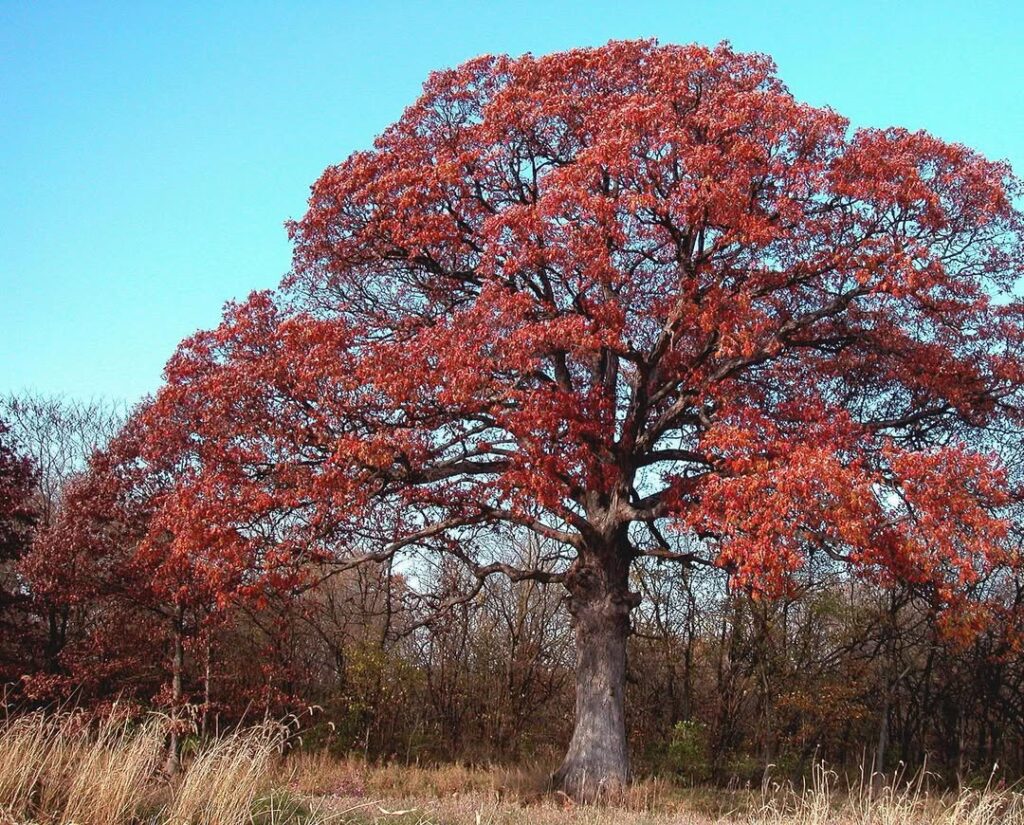
The White Oak stands as Rhode Island’s most iconic heritage tree, reaching majestic heights of 80-100 feet with lifespans exceeding 600 years. This slow-growing native develops a distinctive broad crown with massive horizontal branches, making it a cornerstone species in New England’s forest ecosystems.
Recognized throughout Rhode Island for its ecological and cultural significance, the White Oak provides essential wildlife habitat while supporting diverse insect populations. The species produces acorns that serve as food for over 180 species, including numerous birds and mammals native to the region. Its durable, fine-grained wood has historically been prized for furniture, shipbuilding, and construction, cementing its status as both a natural treasure and heritage species in Rhode Island’s conservation efforts.
- Hardiness: Zones 3-9, native throughout Rhode Island and eastern North America
- Light: Full sun to partial shade, develops best crown structure in open areas
- Water: Moderate moisture requirements, drought tolerant once established
- Soil: Well-drained, acidic to neutral soils; prefers deep, moderately rich conditions
- Fertilizer: Generally not needed when planted in appropriate native soil conditions
- Pest/Disease Resistance: Good resistance to most pests and diseases when healthy
- Growth Rate: Slow, adding 12-24 inches annually under ideal conditions
Black Walnut
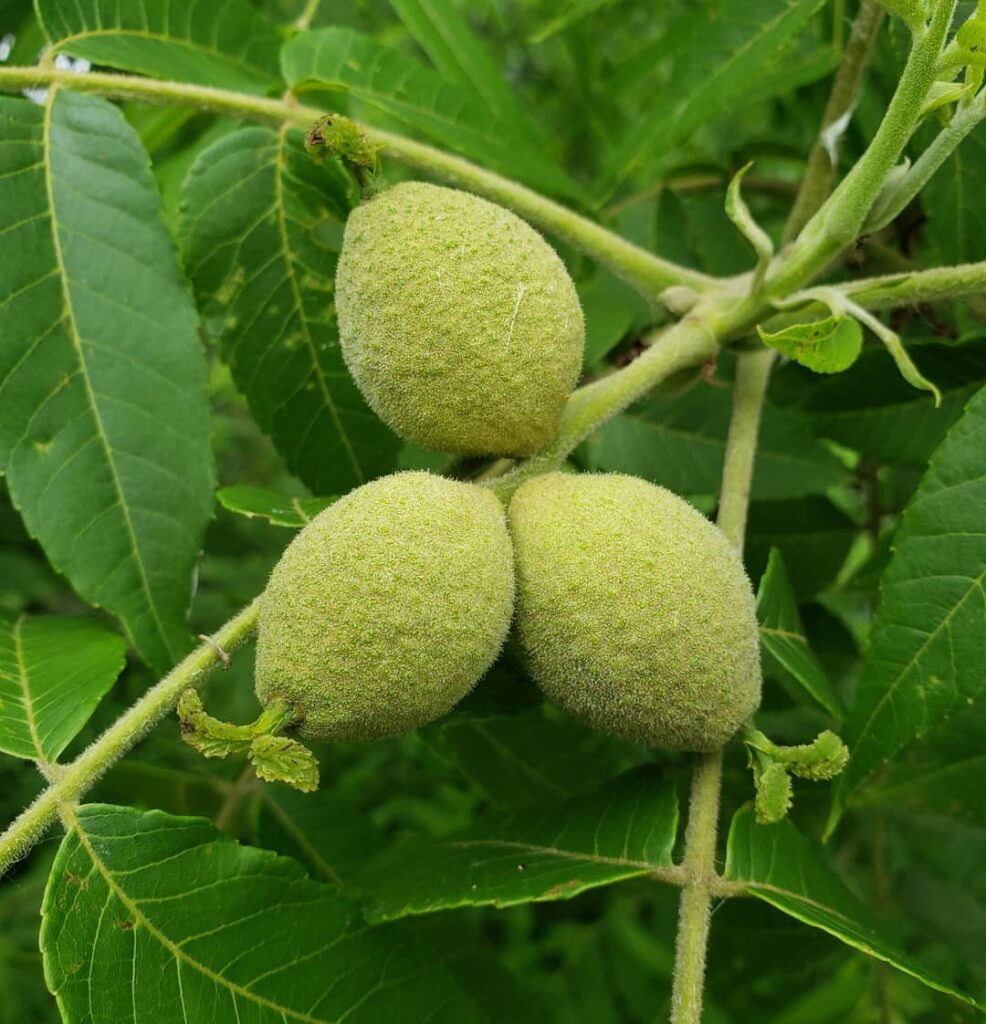
Black Walnut is a magnificent deciduous tree that can reach 50-75 feet in height and width, with some specimens growing to 150 feet tall. This monoecious tree features distinctive compound leaves up to 2 feet long with 5-11 pairs of leaflets, dark furrowed bark, and an umbrella-like crown. The tree produces spherical nuts 1½ to 2¼ inches in diameter enclosed in yellowish-green husks that ripen in fall.
Black Walnut takes approximately 150 years to mature and develops a deep, wide-spreading root system. The tree exhibits allelopathic properties, releasing chemicals that can affect surrounding plants. Its wood is prized for being beautiful, strong, and rot-resistant, while most parts of the tree emit a characteristic pungent odor. Once a dominant species in midwestern and southeastern forests, Black Walnut populations have been significantly reduced due to harvesting and agricultural clearing.
- Hardiness: Zones 4-9
- Light: Full sun
- Water: Moderate; drought tolerant once established
- Soil: Deep, well-drained, fertile soil; pH 6.0-7.5
- Fertilizer: Low maintenance; benefits from organic matter
- Pest/Disease Resistance: Susceptible to walnut caterpillar, aphids, and thousand cankers disease
- Growth Rate: Moderate to fast
Sugar Maple
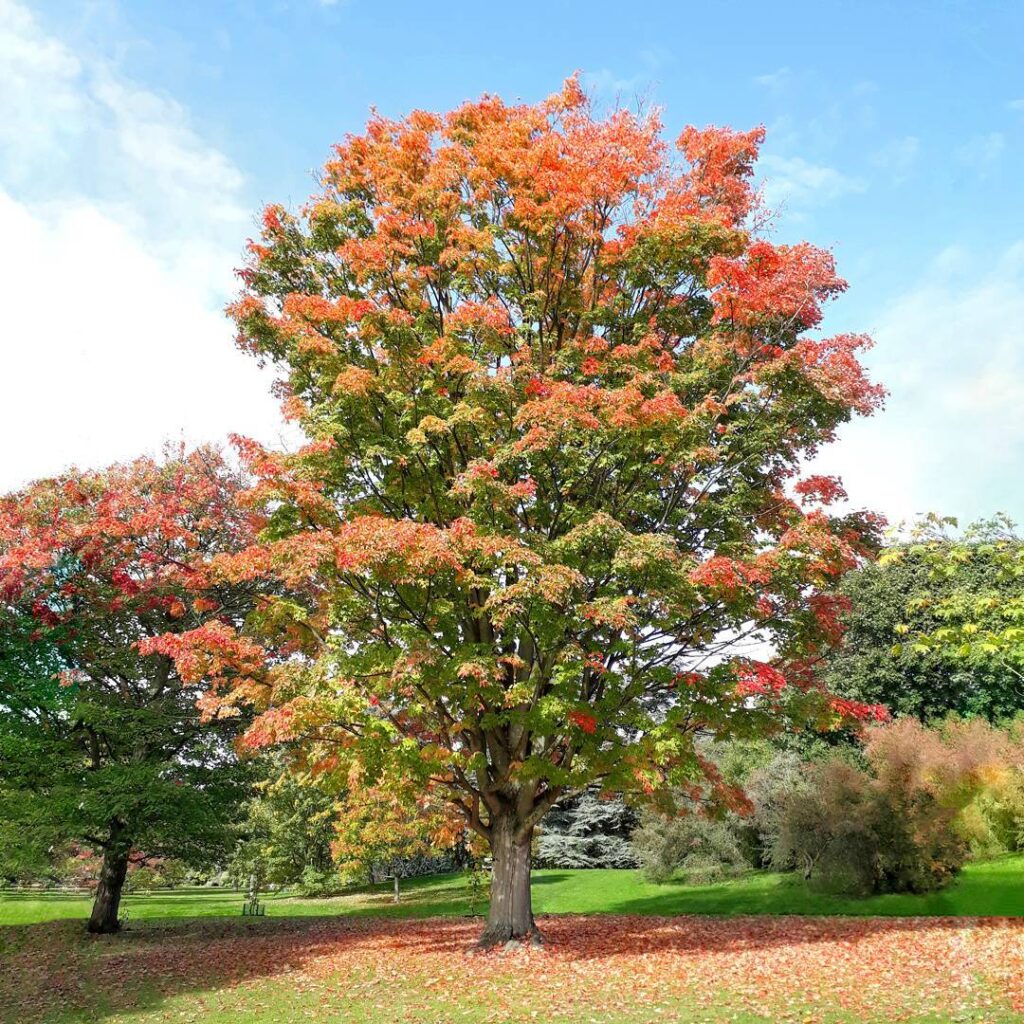
Sugar maples stand as living monuments to Rhode Island’s colonial heritage, with some specimens planted by early settlers still thriving today. These majestic deciduous trees reach 70-90 feet tall, developing characteristic deeply fissured bark and dense, rounded crowns that provide exceptional shade. Their distinctive lobed leaves create stunning fall displays of yellow, orange, and red before dropping for winter.
As one of New England’s most emblematic native trees, sugar maples have shaped both the landscape and economy of the region for centuries. Their sap historically supported thriving maple syrup industries, while their golden-brown wood became prized for furniture making. The sugar maple’s iconic leaf design serves as the centerpiece of the Canadian flag, demonstrating its cultural significance across North America. Today, these heritage trees continue connecting modern Rhode Island landscapes to their colonial past.
- Hardiness: USDA zones 3-8, well-suited to Rhode Island’s climate
- Light: Full sun to partial shade, tolerates shade conditions
- Water: Moderate moisture requirements, drought tolerant once established
- Soil: Well-drained soils preferred, adaptable to various soil types
- Fertilizer: Generally not required in native settings, benefits from organic matter
- Pest/Disease Resistance: Generally hardy with good natural resistance
- Growth Rate: Moderate to slow growth rate, long-lived species
Rhode Island’s Hardy Native Shrubs
Rhode Island’s diverse native shrubs offer excellent solutions for various landscape conditions, from wetland environments and woodland edges to challenging coastal zones requiring exceptional wind and salt tolerance. These hardy species require less maintenance than non-native alternatives while providing natural beauty and ecological benefits to both professional landscaping projects and residential gardens.
Northern Bayberry
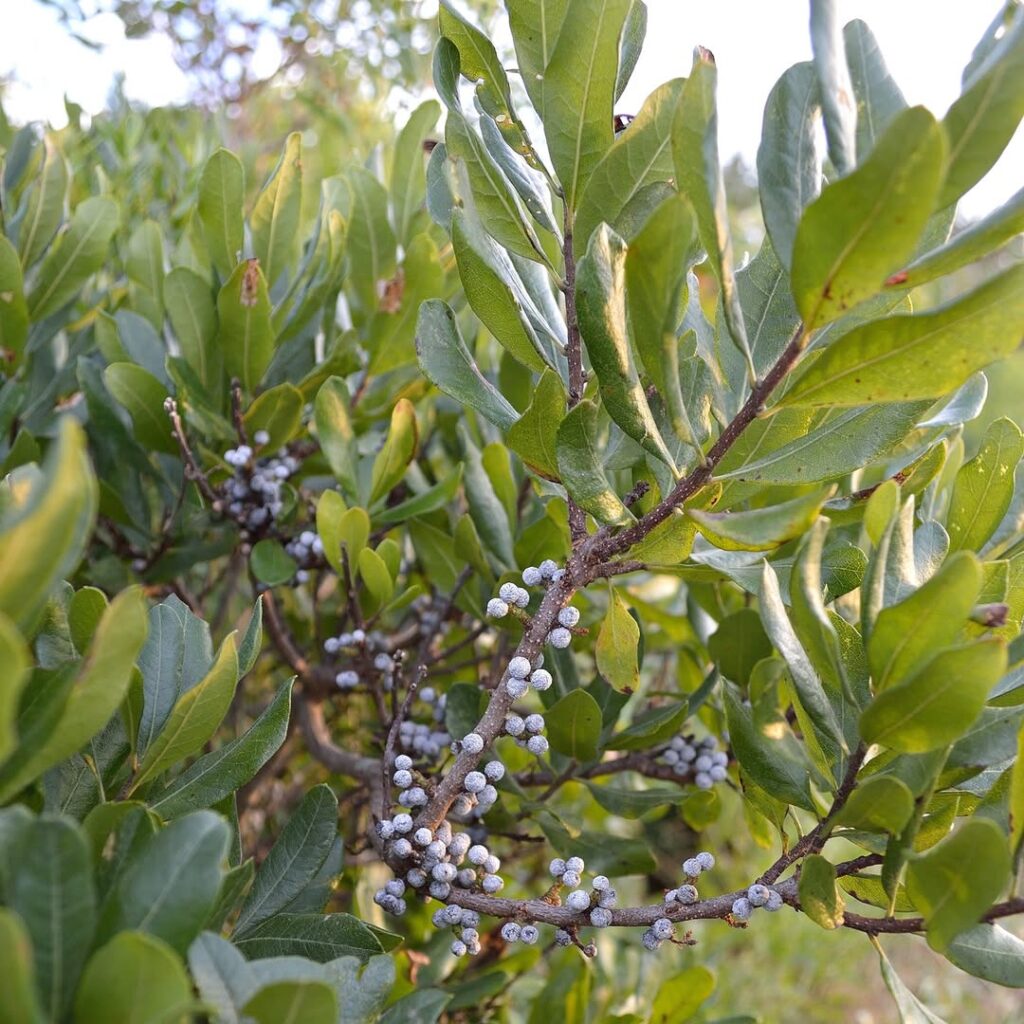
Northern Bayberry stands as one of Rhode Island’s most resilient native shrubs, perfectly adapted to the state’s challenging coastal conditions. This dense, rounded shrub reaches 6-8 feet in height and features glossy, aromatic foliage that releases a distinctive fragrance when crushed. Female plants produce persistent silvery-gray berries that provide essential winter food for wildlife.
The plant’s remarkable tolerance for salt spray, drought, and poor soils makes it invaluable for coastal landscaping and restoration projects. Northern Bayberry forms colonies through suckering and offers multiple ecological benefits, including nitrogen fixation through symbiotic relationships with soil bacteria. Its extensive root system provides excellent erosion control while creating habitat for small animals and birds. The species also serves as a larval host for the Columbia silkmoth, supporting important native pollinators.
- Hardiness: Extremely hardy, tolerates salt spray, high winds, and harsh coastal conditions
- Light: Full sun preferred, adaptable to various light conditions
- Water: Drought tolerant once established, also tolerates wet sites
- Soil: Thrives in sandy, acidic soils; tolerates poor soils and peat conditions
- Fertilizer: None required due to nitrogen-fixing ability
- Pest/Disease Resistance: No serious insect or disease problems; aromatic foliage deters deer
- Growth Rate: Rapid growth with spreading habit through suckers
Winterberry Holly
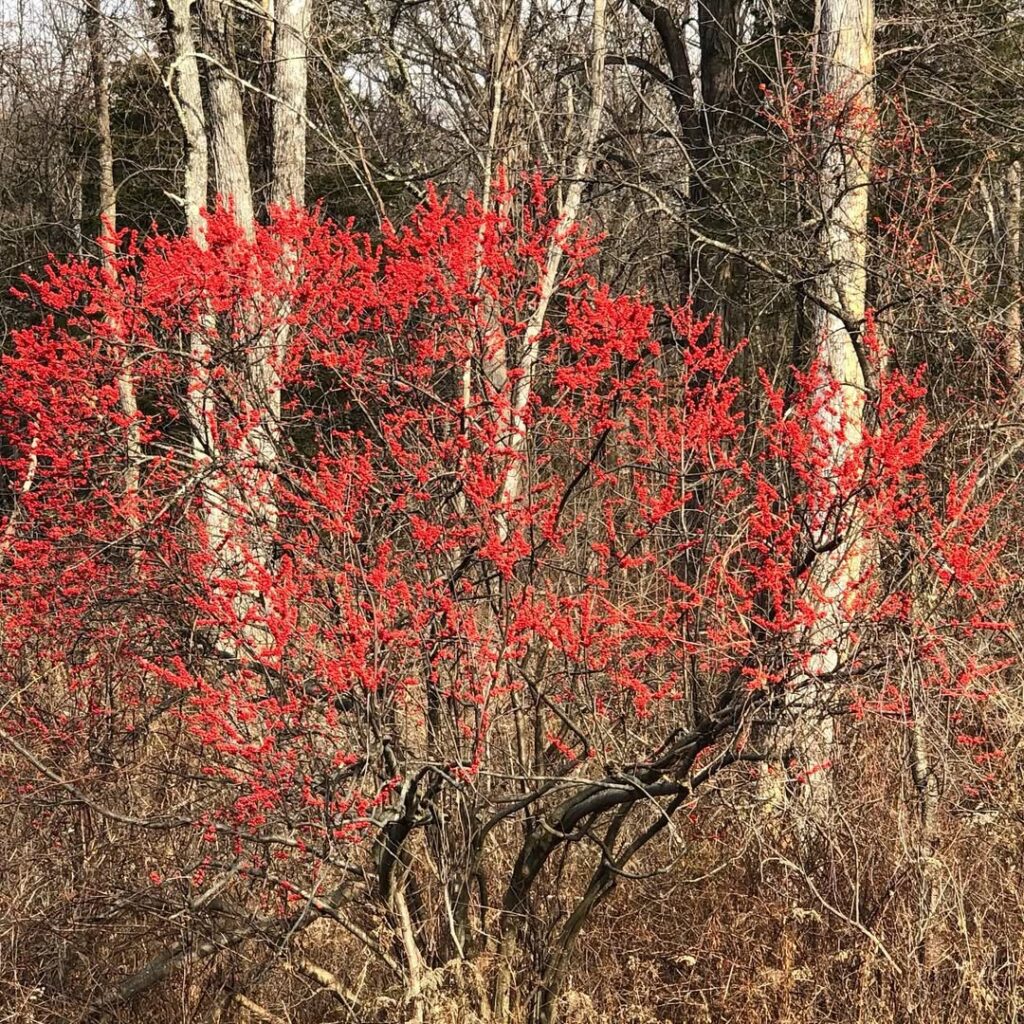
Winterberry Holly is a deciduous native shrub that thrives throughout Rhode Island’s wetland areas and beyond. Growing 3-12 feet tall with dense, zigzag branching patterns, this adaptable plant produces vibrant red berries that persist through winter, providing essential food for birds during harsh months. The shrub’s yellow fall foliage drops to reveal brilliant red berries against bare stems, creating stunning winter interest. Both male and female plants are required for berry production, making this low-maintenance native an excellent choice for rain gardens, naturalized borders, and wildlife habitat enhancement. This species is perfectly suited for wetland margins, swamps, and shores of rivers or lakes throughout its natural range.
- Hardiness: USDA zones 3-8 or 9
- Light: Full sun to partial shade
- Water: Moist to wet conditions; tolerates occasional flooding
- Soil: Acidic, heavy, poorly-drained soils preferred
- Fertilizer: Low requirements; thrives without supplemental feeding
- Pest/Disease Resistance: High resistance compared to non-native alternatives
- Growth Rate: Moderate to fast in suitable conditions
Elderberry
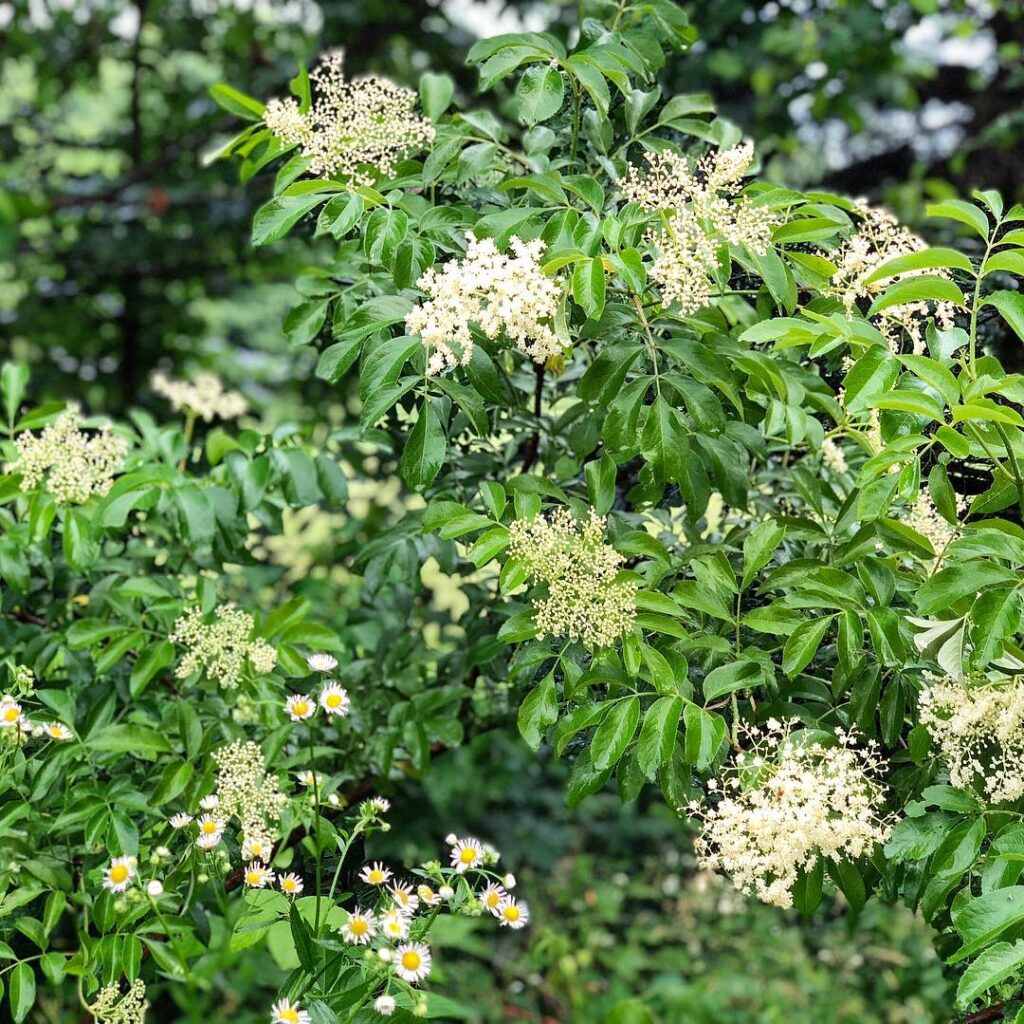
Elderberry is a versatile deciduous shrub native to North America that thrives throughout Rhode Island’s diverse landscapes. Growing 5-12 feet tall with a 6-10 foot spread, this hardy plant features clusters of small white flowers in summer followed by purple-black berries in fall. The aromatic blooms attract butterflies and bees, while the nutritious fruits provide essential food for songbirds and mammals.
Beyond its ecological value, elderberry offers practical benefits as both an ornamental and edible landscape plant. The berries can be transformed into jellies, pies, syrups, and wine, making it a valuable addition to any native garden. Its adaptable nature and multiple weak stems arising from the crown create excellent nesting habitat while providing year-round visual interest.
This native shrub commonly establishes along forest edges, meadows, and fields throughout Rhode Island’s varied terrain. Hardiness: USDA zones 3-8, extremely cold tolerant
- Light: Full sun to partial shade, adaptable to various light conditions
- Water: Moderate to high moisture needs, tolerates both wet streambanks and drier upland soils
- Soil: Prefers rich, moist, slightly acidic soil but adapts to wide range of soil types
- Fertilizer: Low maintenance, thrives without supplemental feeding in native conditions
- Pest/Disease Resistance: Generally resistant with few serious pest or disease issues
- Growth Rate: Moderate to fast growing, establishes quickly from dormant seeds
Spicebush
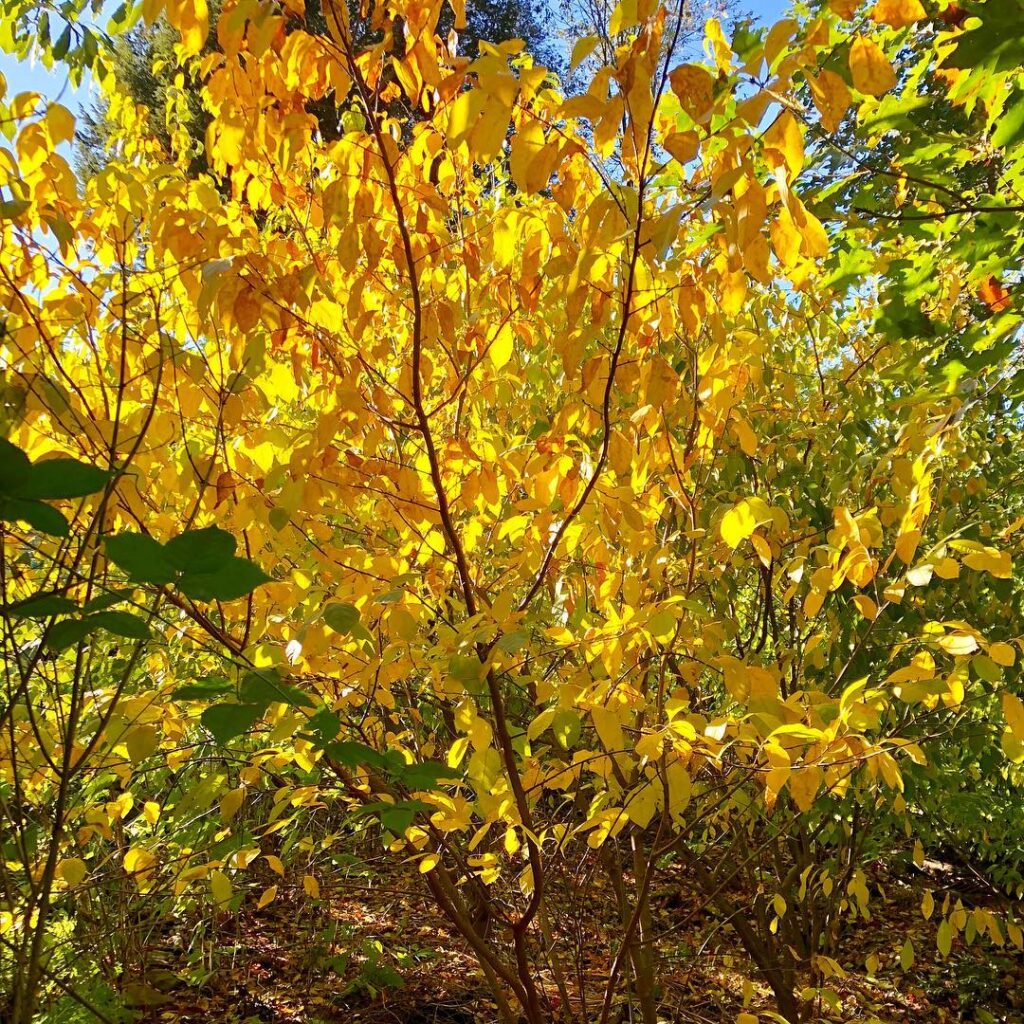
Spicebush (Lindera benzoin) is a valuable native deciduous shrub that can reach up to 15 feet tall in Rhode Island’s woodlands. This aromatic plant thrives in swamps, stream margins, and riparian forests, producing clusters of pale yellow flowers in early April that provide essential nectar for pollinators when few other food sources are available.
Beyond its early spring blooms, spicebush offers exceptional ecological value as the host plant for Spicebush Swallowtail butterfly caterpillars. Female plants produce bright red berries in fall that serve as significant nutrition for migrating songbirds, thrushes, and vireos. The plant displays attractive golden yellow fall foliage and maintains interest through winter with its distinctive branching structure and aromatic twigs. Spicebush is dioecious, with male and female flowers occurring on separate plants.
- Hardiness: Cold hardy in Rhode Island’s climate zones
- Light: Full sun to full shade; highly adaptable to varying light conditions
- Water: Prefers moist, well-drained soils but tolerates wet conditions
- Soil: Sandy loam or medium loam; medium tolerance for calcareous soils
- Fertilizer: No special fertilizer requirements; thrives in native soil conditions
- Pest/Disease Resistance: Excellent; no serious disease or insect problems
- Growth Rate: Fast-growing with dense growth habit
Sweet Pepperbush
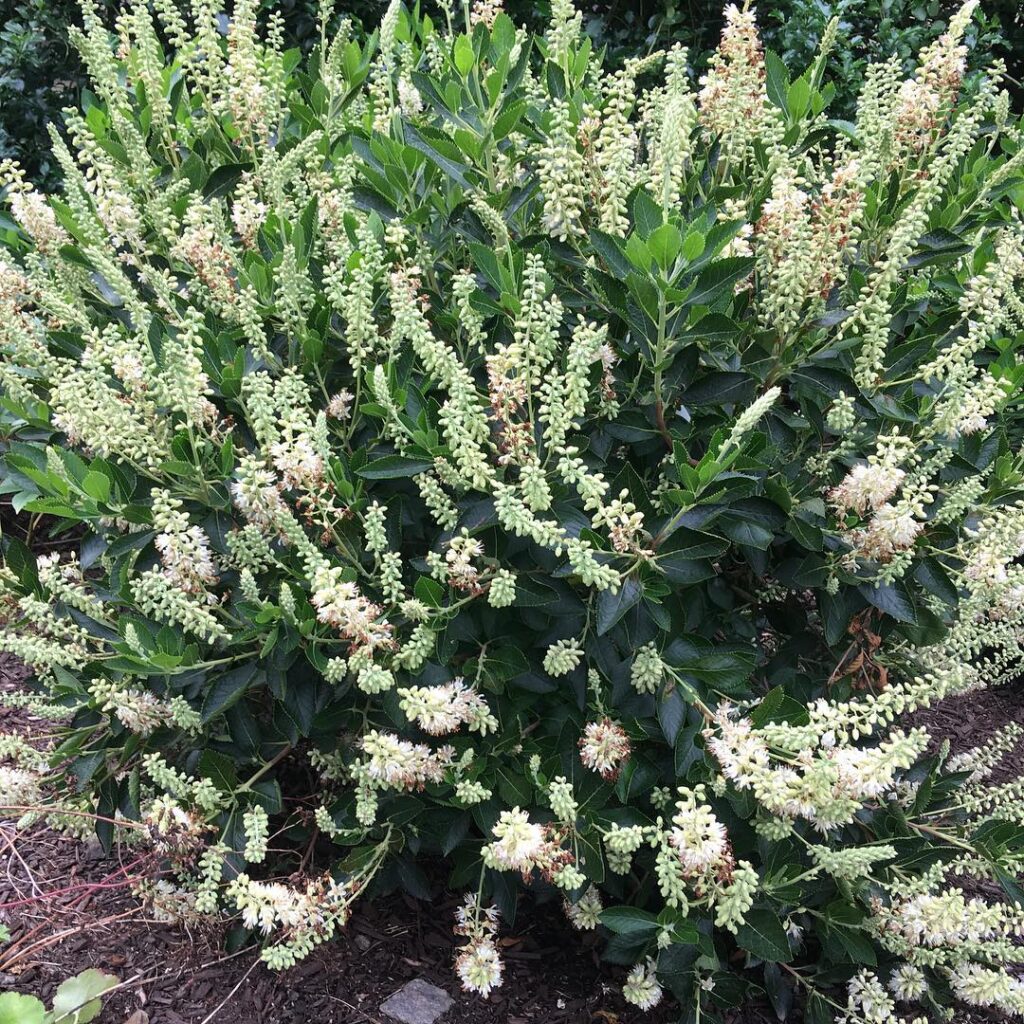
Sweet Pepperbush is a hardy native shrub that grows 6-12 feet tall, forming attractive mounded clumps throughout Rhode Island’s wetlands and coastal areas. This deciduous shrub features dark glossy green leaves that turn golden yellow in fall, and produces fragrant white to pinkish flower spikes from July through August. The spicy-sweet blooms attract butterflies, bees, and hummingbirds, making it an excellent choice for wildlife gardens and native plant landscapes. The plant spreads naturally through stolons, creating moderate density colonies over time.
- Hardiness: Cold hardy native to Rhode Island
- Light: Full sun to partial shade
- Water: Wet to average soils; drought tolerant once established
- Soil: Adaptable to various soil conditions, naturally found in wetland and terrestrial habitats
- Fertilizer: Low maintenance, no special fertilizer requirements
- Pest/Disease Resistance: Good resistance as a native species
- Growth Rate: Moderate to fast growth, reaching 4-8 feet tall with 4-6 foot spread
Selecting the Right Native Plants for Your Garden
How do you choose native plants that’ll actually thrive in your specific Rhode Island garden conditions? Start by evaluating your site’s sun exposure, moisture levels, and soil type. Full-sun areas work perfectly for Black-Eyed Susan and Butterfly Weed, while shaded spots suit Northern Maidenhair Fern and Red Trillium beautifully.
Consider moisture carefully. Wet areas benefit from Swamp Milkweed and Cardinal Flower, whereas drier spots handle Little Bluestem well. Smart plant combinations enhance both garden design and functionality—pair early-blooming Eastern Red Columbine with late-season Goldenrod for extended color.
Think about wildlife goals too. Common Milkweed supports monarchs, while Elderberry feeds birds year-round. The Rhode Island Native Plant Guide offers a simple online tool that allows you to search based on your specific plant type preferences and site characteristics.
Frequently Asked Questions
How Do I Propagate Native Rhode Island Plants From Seeds?
You’ll start with seed collection from local Rhode Island sources, then apply cold stratification. Use proper germination techniques like surface sowing for light-requiring seeds, maintaining humidity, and providing warm LED lighting for ideal results.
What Native Plants Attract Butterflies and Hummingbirds in Rhode Island?
Coincidentally, you’ll discover butterfly gardens and hummingbird feeders aren’t your only options. Plant cardinal flower, bee balm, wild columbine, and boneset to naturally attract both species while supporting Rhode Island’s native ecosystem.
When Is the Best Time to Plant Native Species in Rhode Island?
You’ll find three excellent planting seasons in Rhode Island. Spring offers ideal conditions starting May 1st, fall allows natural seed stratification, while summer requires extra watering but works with drought-tolerant natives.
How Do I Control Invasive Species That Compete With Native Plants?
Picture invasive species as unwelcome guests crowding out your garden party. You’ll control native plant competition through early detection, hand-pulling small infestations, applying selective herbicides for larger areas, then replanting natives to prevent reinvasion.
What Native Plants Are Deer-Resistant in Rhode Island Gardens?
You’ll find excellent deer resistant shrubs like Inkberry and Great Laurel that deter browsing through toxicity or dense growth. Native groundcovers including Wild Ginger and ferns provide aromatic foliage that naturally repels deer.
